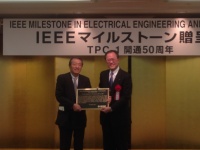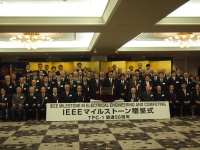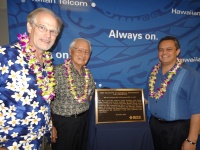Milestones:TPC-1 Transpacific Cable System, 1964: Difference between revisions
No edit summary |
No edit summary |
||
| Line 1: | Line 1: | ||
{{MilestoneLayout|citation=The First Transpacific Cable System (TPC-1), 1964 | {{MilestoneLayout|citation=The First Transpacific Cable System (TPC-1), 1964 | ||
<br> | <br> | ||
The first transpacific undersea coaxial telephone cable linking Japan, Hawaii, and the U.S. mainland was completed in 1964. President Lyndon B. Johnson and Prime Minister Hayato Ikeda inaugurated this communications link on 19 June 1964. This joint project involving American Telephone and Telegraph, Hawaiian Telephone Company, and Kokusai Denshin Denwa improved global communication and contributed to deep water submarine cable technologies. | The first transpacific undersea coaxial telephone cable linking Japan, Hawaii, and the U.S. mainland was completed in 1964. President Lyndon B. Johnson and Prime Minister Hayato Ikeda inaugurated this communications link on 19 June 1964. This joint project involving American Telephone and Telegraph, Hawaiian Telephone Company, and Kokusai Denshin Denwa improved global communication and contributed to deep water submarine cable technologies. | ||
Revision as of 14:20, 27 October 2015
Title
Citation
The First Transpacific Cable System (TPC-1), 1964
The first transpacific undersea coaxial telephone cable linking Japan, Hawaii, and the U.S. mainland was completed in 1964. President Lyndon B. Johnson and Prime Minister Hayato Ikeda inaugurated this communications link on 19 June 1964. This joint project involving American Telephone and Telegraph, Hawaiian Telephone Company, and Kokusai Denshin Denwa improved global communication and contributed to deep water submarine cable technologies.
Street address(es) and GPS coordinates of the Milestone Plaque Sites
, [1] KDDI Corporation, Garden Air Tower, 3-10-10, Iidabashi, Chiyoda-ku, Tokyo, 102-8460 JAPAN (coordinates: 35.700463, 139.750537) [2] Hawaiian Telcom, 1177 Bishop Street, Honolulu, Hawaii, 96822 U.S.A. (coordinates: 21.309688, -157.859081)
Details of the physical location of the plaque
[1] The plaque is publicly accessible. [2] The plaque is publicly accessible.
How the plaque site is protected/secured
[1] The plaque site is within KDDI Headquarter, and is under the propoer security control. The visitors can access with prior appointment to KDDI (International Network Department, +81 3 6678 0800). [2] The plaque is within HT Headquarter, and is under the proper security control. The visitors can access at the normal business hour.
Historical significance of the work
The Transpacific Cable System No.1 “TPC-1” was a submarine telephone cable connecting the U.S. mainland to Japan with a total length over 10,000km. TPC-1 became operational on 19th June 1964 with the congratulatory speeches of President Lyndon B. Johnson of U.S.A. and Prime Minister Hayato Ikeda of Japan noting the importance of the project for the U.S.A. and Japan. It has contributed to a closer relationship and to the mutual development in culture and economy between U.S.A. and Japan. It also triggered the rapid development of submarine telephone cable networks in Eastern Asia, providing large communications capacity between Eastern Asia and U.S.A./Europe. TPC-1 was a US$83Million project, which was jointly constructed by AT&T, HTC and KDD, by applying the state of the art technology (“SD” type cable system design), developed by Bell Laboratories of AT&T, following previous SA & SB designs. A newly established Japanese company, Ocean Cable Company (OCC), also manufactured some portions of the submarine cable under AT&T’s supervision. TPC-1 was composed of three cable networks; 1) TPC-1 connecting Japan with Hawaii via Guam, Midway and Wake, 2) HAW-1 and HAW-2 connecting Hawaii and the mainland U.S.A. and 3) Guam-Philippines Cable, a branch of TPC-1. TPC-1 was also cross connected at Hawaii with COMPAC, the British Commonwealth cable linking Canada, New Zealand and Australia, which opened for service in 1963. TPC-1 and COMPAC formed the Pan Pacific coaxial submarine cable network. TPC-1 began operation in June, 1964, and was followed by joining of Guam-Philippines Cable in December, 1964. Since then, TPC-1 was in operation more than a quarter century, and will achieve its 50 year anniversary in 2014. The quality of telephone circuits of the longest multi links through TPC-1, land cables on the North American Continent and submarine cables in Atlantic Ocean was proven to satisfy the CCITT voice quality recommendations the first time. The technology developed in the SD type cable covers the implementation of cables undersea. This included machinery on board a cable ship and methodologies of cable laying and repairing, which became the standard going forward. The technology developed in TPC-1 continues to be the foundation for the construction and maintenance in current fiber optic submarine cables used for international telecommunication today.
Features that set this work apart from similar achievements
In order to satisfy the need for stable telephone communication between Eastern Asia and the U.S.A./Europe, establishing a new world order after the second world war, the U.S.A. and Japan agreed to construct TPC-1 as a national project for both countries and, AT&T, HTC and KDD signed the “TPC-1 Construction and Maintenance Agreement (C&MA)” in February 1962. TPC-1 improved the voice communication between Asia and the U.S.A./Europe from the previous media, interruptible and unstable “short wave radio”. After the completion of the construction, the telephone traffic through TPC-1 grew more than 50 percent every year, which demonstrated the significant contribution and importance of TPC-1 to the social and economic activities between Asia and the U.S.A./Europe. The telecommunication development in quality and quantity introduced by TPC-1, together with the development in transportation, drastically enhanced the inter-continents activities in community exchange and import/export. This increase showed the potential growth in telecommunication traffic between Eastern Asia and the U.S.A./Europe, which accelerated the construction of submarine cable networks in East Asia and South East Asia (such as JASC, China-Japan, Korea-Japan, Taiwan-Okinawa, OLUHO, ASEAN cables with the total lengths more than 10,000km), and subsequently contributed to the harmony between Eastern Asia and the U.S.A./Europe. The significant part of the SD cable, manufactured by OCC, and some telecommunication equipment, such as channel banks, echo suppressors, international telephone exchange switches for TPC-1, were developed and manufactured in Japan under the co-supervision of AT&T and KDD. AT&T, HTC and KDD’s enhanced coordination and collaboration in implementing TPC-1, lead to the successful achievement of TPC-1 and subsequent future cable systems active today.
Significant references
(1)Article on Japan Times (June 20, 1964) [attached]. (2)Article on New York Times (June 19, 1964) [attached]. (3)Article on Japan Times (February 16, 1962) [attached]. (4)TPC-1 Construction & Maintenance Agreement [attached]. (5)
Supporting materials
(7)TPC-1 Movie in Japanese (English version is availabel by DVD). http://www.kagakueizo.org/movie/industrial/78/ (8)
http://www.ieee-region6.org/2014/hawaii-section-ieee-engineering-milestone-presentation
Article on the COMPAC cable between Canada and Australia and New Zealand http://ieeexplore.ieee.org/stamp/stamp.jsp?arnumber=5176172
<googlemap controls="small" height="250" width="300" zoom="10" lon="139.750537" lat="35.700463" version="0.9"> 35.700463, 139.750537, Transpacific Cable, 1964 Tokyo, Japan </googlemap>
<googlemap controls="small" height="250" width="300" zoom="10" lon="-157.859081" lat="21.309688" version="0.9"> 21.309688, -157.859081, Transpacific Cable, 1964 Honolulu, Hawaii, U.S.A. </googlemap>
Map


